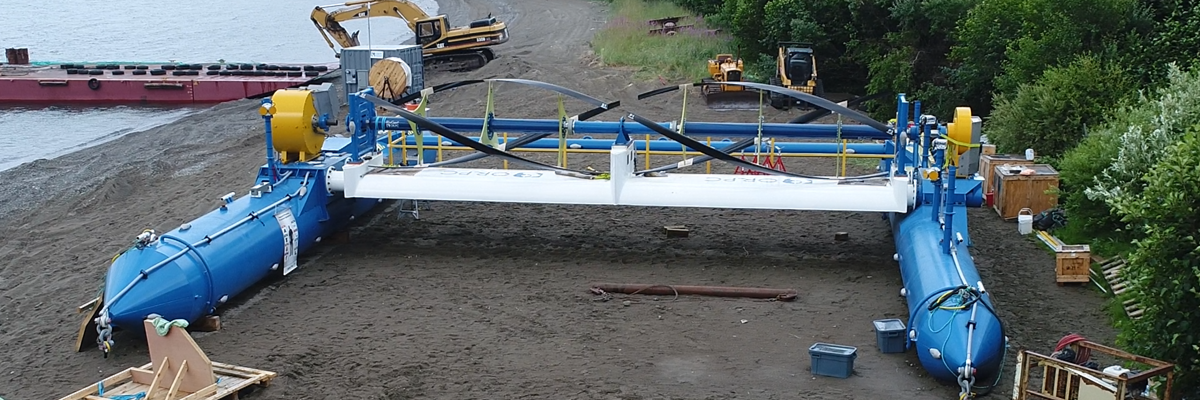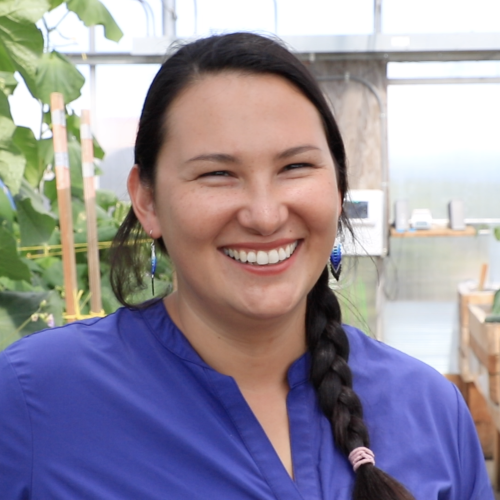Inspiring tales of energy innovation from the top of the world

ORPC's RivGen system preparing for deployment in Igiugig, Alaska
By Peter Asmus
January 19, 2024
Alaska, and the Arctic in general, have captured the imagination of peoples, including explorers and entrepreneurs, for centuries. Nation after nation have sought pathways through the far North to foster trade, extract wealth from natural resources, and demonstrate technological and scientific prowess. In his book, A History of the Arctic: Nature, Exploration and Exploitation, John McCannon notes that the Arctic holds a unique and often contradictory place in the western imagination:
Cold and isolated, yet home to some 4 million people; harsh and unyielding, yet disintegrating with every passing year: the Arctic defies definition. In the modern mind, it represents the quintessentially timeless – its landscape imagined both as a realm of crystalizing purity and as a frozen kingdom of dread and death.
When it comes to energy history in the North, Alaska — perhaps the epitome of Arctic contradictions — has long been associated with the discovery of oil and natural gas. These resources provided tremendous economic benefits for the 49th State, but because they were primarily an export opportunity, this resource wealth didn’t address local residents’ own high energy cost burden. As glaciers melt and permafrost thaws, treasured species of fish such as salmon and crab decline, oil reserves wane and consumer energy bills continue to rise, Alaska is re-evaluating its energy future. The good news is that many rural Alaska communities are already leading the way towards a new energy future for the state.
Since the mid-1990s, renewable energy integration projects have sprung up in Alaska’s rural communities not due to regulatory fiat but rather economic necessity. Alaska’s electricity costs are among the highest in the nation. This is linked to the remoteness of the largest portfolio of microgrids in the U.S., the majority of which have traditionally been heavily dependent on expensive and dirty diesel fuel. While there is no doubt the diesel generator is a workhorse technology across the globe in places without traditional grid infrastructure, availability and logistics linked to transporting diesel and other fossil fuels prompted many rural Alaska utilities to turn to renewable and locally available energy resources.
I came to know the Alaska story after more than 30 years of writing and analyzing global energy trends, with a focus on the cutting edge, chronicling the history of wind power, California’s own unique energy legacy, and then later microgrids. I currently serve as executive director of the Alaska Microgrid Group, a small consultancy doing work inside and outside of Alaska. I also serve as senior advisor on microgrid strategy and thought leadership for ACEP, drawing upon my global knowledge about emerging energy trends, much of it gleaned from previous consulting work at Guidehouse Insights and the writing of three previous books on energy topics. So when ACEP leadership discussed the opportunity to compile a book showcasing Alaska’s inspiring innovations in rural energy and the dedicated people behind their success, I enthusiastically agreed.
This blog is the introduction for a new blog series that will feature excerpts from a forthcoming University of Alaska Press book entitled Alaska’s Energy Innovators: How Communities Are Responding to the Climate Crisis. It will feature stories from Alaska’s energy innovators from across the energy industry, including utilities, academics, Native peoples, entrepreneurs, non-profit public policy advocates and more. The focus will be on the individuals describing in their own voices how they each helped develop a more affordable and sustainable energy system. The book will also highlight how the Alaska Center for Energy and Power (ACEP) has promoted new technologies through supportive community partnerships and technical assistance to remote communities lacking traditional grid infrastructure.
Alaska’s Energy Innovators provides a lens to explore how climate change has refocused the story of Alaska’s energy development history. Rather than telling the well-known story of oil and natural gas development in the 49th State, this book will instead focus on how Alaskan innovations in wind, solar, hydro and other low-carbon energy resources — including energy efficiency — have delivered immense economic savings and environmental benefits to state residents and the world alike.
Alaska’s bottom-up solutions

Representatives from the Department of Energy's Arctic Energy Office and NANA tour Kotzebue Electric Association's wind and solar farm.
Beginning with a short history lesson provided by professor Phil Wight of the University of Alaska Fairbanks to set the stage, Alaska’s Energy Innovators chronicles how extractive oil and gas industries, mining and then commercial fisheries, all played a pivotal role in bringing power infrastructure to the state. The personal stories of several women, including Gwen Holdmann, who started up ACEP, as well as Clarissa Quinlan and Connie Fredenburg, who
collaborated in a successful project that demonstrated how prepay electricity meters brought financial stability to Alaska’s smallest and most remote communities, are chronicled as well. Meera Kohler, who recently retired as CEO of the Alaska Village Electric Cooperative (AVEC), a utility that serves the largest area of any retail electric cooperative in the world, also contributes a chapter showcasing how cooperatives thrive in Alaska.
The central core of the book will trace specific community energy case studies such as that of Cordova, a fishing port at the mouth of the Copper River unconnected to any roads and often blasted by wind and rain. Home to one of the most innovative utilities in the world, Cordova’s energy history encapsulates the roller coaster nature of energy system evolution in Alaska. Clay Koplin, CEO of Cordova Electric Cooperative, contributes a chapter to this book that notes the utility started out as 100% hydro, then shifted to 100% diesel, and then arrived at its current status: a hybrid hydro-diesel system that leverages modern batteries to limit fossil fuel combustion, balancing this small and fragile grid in unprecedented ways. Undergrounding power lines here is not a new idea; a solution now being touted by some large utilities in the lower 48. Free electric vehicle (EV) charging in Cordova reflects the ethos of many of the electric cooperatives in Alaska, the most popular utility format in the state. Power to the people would be an appropriate slogan guiding the efforts of these cooperatives — especially those operating fully-islanded isolated power systems now known as microgrids.

AlexAnna Salmon of Igiugig, Alaska
Darron Scott of Kodiak Island, home to a virtual 100% renewable energy microgrid, and Brad Reeve of Kotzebue, an early adopter and innovator in wind technology in Alaska, are now also integrating solar energy into their respective remote microgrid resource mix and provide compelling stories of hope against tall odds in two of Alaska's most inspiring microgrid transformations. Perhaps the most evocative community story is that of AlexAnna Salmon of Igiugig, a utility that serves less than 70 people. Viewing the world’s energy challenges through the eyes of an Indigenous woman whose community is blazing trails with tidal power that draws clean electricity from a river that has sustained this small community for millennia is truly eye-opening. The story of another Alaskan Native innovator — Ed Bifelt, founder of Alaska Native Renewable Energy Industries — highlights more recent trends in Alaska of relying upon independent entrepreneurs to bring solar power to a variety of villages.
Alaska’s innovation to date has been fostered by 100 utilities serving less than 800,000 people (and a few of said utilities serve less than 100 people). By contrast, some large private utilities in the continental U.S. serve more accounts than the entire population of Alaska. Alaska’s decentralized approach has fostered innovation out of necessity. Renewables simply make economic sense. But shifting to variable and weather-dependent renewables also requires integration ingenuity. The logistics of cold weather installations and ongoing maintenance in such harsh and remote environments remain a challenge today. In short, Alaska’s decentralized market has allowed for individuals and communities to make their marks in a way that has not been replicated anywhere else. Lessons learned here carry broad implications across the globe.
The next chapter in Alaska’s energy story
Today’s climate crisis is stimulating a debate in Alaska about the next chapter in the state’s fascinating energy history. Can the state build upon its past innovation, which was driven largely by local decision-making with support from federal and state government grants, and take the next steps toward decarbonization?
The Railbelt Grid, the only major transmission system in the state, lags behind the remote communities referenced above in renewable energy adoption. Because Railbelt customers enjoy lower cost electricity, utilities serving the Railbelt haven’t had the same financial pressure to diversify and innovate as those serving rural customers. The Railbelt utilities have not yet to embrace the types of market reforms that are revolutionizing relationships between utilities and their customers in the rest of the U.S. and other parts of the world such as Australia, Japan and Europe and therefore suffer from inefficiencies due to the lack of an integrated market that would enable trading between each of the interconnected utilities. “The Railbelt is where the carbon is,” as Steve Colt of ACEP says. He, along with former University of Alaska chancellor and state legislator Brian Rogers, detail their stories and current efforts in Alaska’s Energy Innovators to move Alaska forward with reforms and new strategies. If Alaska wants to continue to make progress in reducing its collective carbon footprint, the Railbelt Grid, which serves two of Alaska’s biggest cities, can no longer afford to be a laggard.
While much of this forthcoming book celebrates the virtues of decentralized remote microgrid development with each community carving their own pathway to reduce costs and emissions, the severity of the climate crisis may require a new approach. Such is the perspective of Chris Rose, executive director of the Renewable Energy Alaska Project (REAP) which has been championing public policy changes for years, often to no avail. His is the last personal story included in the book. Whether it is common policy tools such as a renewable portfolio standard (RPS) for the Railbelt, or market reforms now common throughout the U.S. and other industrialized energy markets (such as creation of an independent transmission system operator), Rose argues that Alaska now needs to up its game and intervene into its electricity markets in order to improve efficiency, lower costs and simultaneously shrink the state’s electricity production carbon footprints.
The book will conclude with a comparative analysis of Alaska with the rest of the U.S. and the world. This is where I get to add my two cents. Alaskans can celebrate its successes, knowing that the next step on its decarbonization journey will require not only bottom-up ingenuity, but also top-down leadership that leans on lessons learned over the past century or more. New technologies such as EVs, batteries and artificial intelligence all will need to be incorporated into Alaska’s toolkit. Large industrial-scale hydrogen production that leverages legacy oil and gas players will need to be married with better utilization of distributed energy resources that empower formerly passive consumers into prosumers. How to do that in a state where energy costs double the rate of the rest of the U.S. and per capita consumption ranks near the top of all 50 states will be a challenge. But overcoming steep challenges is the Alaskan way. This blog series will feature a different voice each month throughout 2024. Please listen. These innovators have something very important to say and share.


